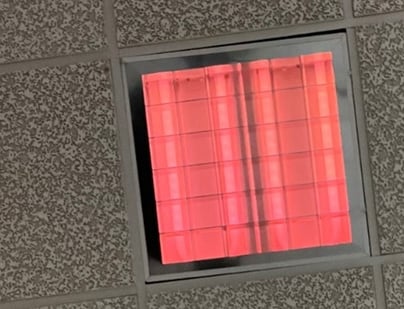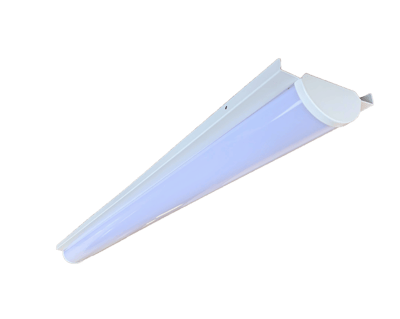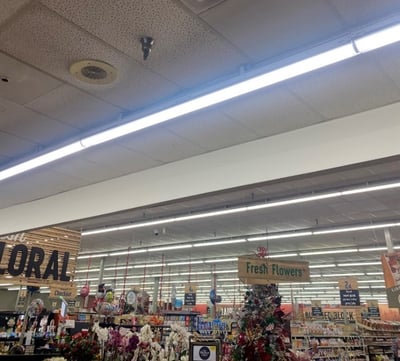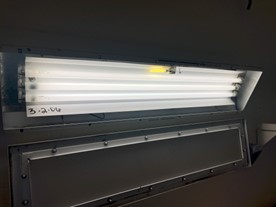 Do you own, manage, or maintain a facility that uses linear fluorescent lighting (LFL)? You might be overspending your budget and sacrificing profit.
Do you own, manage, or maintain a facility that uses linear fluorescent lighting (LFL)? You might be overspending your budget and sacrificing profit.
Using and keeping up with traditional fluorescent lighting (LFL systems) waste a lot of energy and require a lot of maintenance. And that can eat into profits and make maintenance more expensive and time-consuming. That translates to fewer resources available for other important needs of the business or facility.
Below, we’ll cover the pitfalls of replacing/upgrading LFL lighting and walk you through how to choose the best path forward.
What Is Linear Fluorescent Lighting?
LFL fixtures are traditional lighting fixtures like the compact fluorescent bulbs (CFLs), recognized by their corkscrew-like shape.
The difference between the two is size and application:
- CFLs are made to fit in standard household sockets and have a ballast built into the light bulb’s base.
- LFLs, on the other hand, are long and tube-shaped and require a separate ballast independent of the bulb.
What Are the Most Common Issues With LFL Systems?
Excessive Electricity Consumption
LFL systems use a lot of electricity.
A 4-foot fixture, for example, typically uses one to four lamps, sometimes six and eight in high bay mountings. Each lamp consumes 28 to 40 watts. F54T5HO lamps consume 54W per lamp. And that excludes the Phantom Power of the ballast.
Looking at 8-foot fixtures, they range from 75 to 96 watts per lamp, and more if T12HO lamps are installed. So, each fixture could consume up to 828 watts (F96T12/HO x 8 lamps).
It’s likely the facility has a multitude of fixtures across many applications. That’s a significant amount of energy just to light the space.
Recurring Maintenance Costs
Because LFL lamp life expectancy is 9,000 to 45,000 hours on average, fluorescent lamps require frequent replacement. When one or two lamps fail in a multilamp fixture, the performance and illuminance of the entire fixture degrades.
And the costs go beyond new lamps. You’ll also need to pay for labor and materials, like parts, lift rental, and ladders to access the fixture and conduct the replacement. If the life expectancy of the ballast is exceeded or the ballast fails, additional time and material costs are warranted.
Related Reading: Understanding LED Lighting: Rated Life and Product Warranties
When fixtures aren't maintained properly, their performance drops. This can happen for several reasons:
- The light output diminishes over time.
- Lamps turn pink due to depleted mercury dosing.
- Dirt builds up.
- Normal wear and tear on lenses and reflectors happens.
While some of these issues can be fixed, often, the only solution is to replace the entire fixture.
 Image: Mercury starvation exhibited by LFLs
Image: Mercury starvation exhibited by LFLs
Recycling Lamps and Ballasts
Regulations around the disposal of lamps containing mercury and other hazardous minerals must be considered. The United States Environmental Protection Agency (EPA) stipulates the quantity of lamps to be disposed of and frequency of disposal. The EPA recommends that consumers take advantage of available local options for recycling CFLs, fluorescent bulbs, and other bulbs that contain mercury, along with other hazardous waste.
Switching From Linear Fluorescent Lights to LEDs
 So, if LFL systems present many issues, what’s the alternative? Upgrading your facility to LED lighting can provide advantages like:
So, if LFL systems present many issues, what’s the alternative? Upgrading your facility to LED lighting can provide advantages like:
Energy efficiency: A 4-foot LED fixture typically consumes 28 to 60 watts, resulting in a 65% to 80% reduction in your electricity consumption vs. fluorescent fixtures.
Longevity: Rated at 50,000 to over 100,000 hours, LEDs last much longer than fluorescent systems. In addition, LED system warranty periods are normally 5 to 10 years.
Reduced Maintenance: LED systems typically outlast legacy lighting systems due to the solid-state lighting (SSL) design accompanied by reduced heat dissipation.
Augmented Lighting Control: LED systems feature controls for brightness, dimming, shift to warm dim, tunable white, occupancy, vacancy, daylight sensing, and a wide range of color-tuning and RGBW systems. LED systems are programmable for scene creation, time scheduling, step-dim delays, and holds, which allow for an increased level of customization and further reduced energy consumption.
Improved Quality of Light: Legacy fluorescent systems typically offered a few color temperatures: warm white, neutral white, cool white, and daylight white. But LED systems now offer a wide array of colors from warm to cool, and with an improved color rendering index (CRI) of 80 or greater (on a scale of 0-100 [highest]). With increased control and tuning, the quality of the lighted environment is augmented through many platforms better suited for the space, occupants, and task; for improved enjoyment; and for greater safety.
Related Reading: A Guide to Understanding CRI in Lighting
Code Compliance: Modern lighting systems are heavily influenced and mandated according to various local, state, federal, and international codes and regulations. These codes outline requirements for energy conservation, life safety, building standards, and electrical standards. There are too many to list, but the most prominent are:
- International Energy Conservation Code (IECC): The IECC is a widely adopted model building code aimed at improving the energy efficiency of buildings.
- International Building Code (IBC): The IBC is a comprehensive building code that covers all aspects of building construction.
- American Society of Heating, Refrigerating and Air-Conditioning Engineers (ASHRAE): ASHRAE is an organization dedicated to the advancement of heating, ventilation, air conditioning, and refrigeration to serve humanity and promote a sustainable world.
- National Fire Protection Association (NFPA): The NFPA publishes codes and standards intended to minimize the possibility and effects of fire and other risks.
- National Electric Code (NEC): The NEC sets the standard for electrical safety in residential, commercial, and industrial occupancies. It is published by the NFPA: NEC.
- Underwriters Laboratories (UL): UL is a global safety certification company that sets industry-wide standards on safety.
- In addition, authorities may implement local ordinances for scheduling, illuminance, light trespass, and unwanted sky glow (Dark Sky International darksky.org).
Basic LFL-to-LED Upgrade Scenarios
You’ve decided that an LED upgrade is the better option. Now how do you go about it? You’ve got options, including:
Option 1: Lamp-for-Lamp Replacement
This involves simply removing fluorescent lamps and installing LED replacement tubes, known as TLEDs. This may be faster and cheaper than other methods. However, installing a lamp-only lighting replacement into an existing fixture induces potential component failures that require further maintenance and material cost.
Depending on the type of TLEDs being used, the fixture may also require rewiring and lamp holder (tombstone) replacement, which could add to the installation cost and labor.
There are four TLED replacement types as defined by UL. They are:
| Type | Function |
| A | “As Is”: TLED lamp is compatible with the existing LFL ballast. |
| A/B | Lamp compatibility with LFL ballast or line voltage |
| B |
“Bypass”: Ballast removed, and the lamp is connected to mains voltage |
| C | “Compatible” with LED driver (ballast removed and driver installed) |
There are pros and cons for each type.
| Type | Pros | Cons |
| A | Quick change, low cost | Ballast failure, future ballast change. The age of existing ballast is a factor. |
| A/B | Ballast-driven short term, then ballast bypassed | Higher expense, more labor, future ballast removal |
| B |
Ballast removed, line voltage operated lamp |
Rewiring is required depending on double-end powered, or single-end powered lamps. Socket change is required depending on whether existing sockets are shunted or nonshunted. |
| C | Dimmable, more lumens | Higher cost, more labor |
Option 2: Retrofitting Legacy Lighting Fixtures
Another cost-effective solution is to upgrade legacy fixtures by removing existing components (lamps, ballasts, sockets, “belly pans,” ballast covers) and install new LED components; in a sense, “gutting” the fixture in situ. This method is quite common for renovation projects and upgrades where the following issues are of concern:
- Minimizing excess waste and disposal.
- Avoiding labor costs to remove complete fixtures.
- Ability to retrofit expensive vandal-resistant fixtures for jails, prisons, and correctional facilities.
- Avoiding access above the ceiling or into the plenum.
- Exposure to contamination caused by dust, particulates, or asbestos, especially in healthcare spaces.
- Ability to use non-licensed maintenance personnel.
- Maintaining the existing look and ambiance using existing fixtures with architectural significance, specifically buildings on the Historical Register.

Image: Retail space where linear retrofit kits replaced linear fluorescent lamps
 Image: High-security vandal-resistant fixtures with legacy linear fluorescent lamps
Image: High-security vandal-resistant fixtures with legacy linear fluorescent lamps
LED retrofits can be a great way to update your lighting in a short timeframe with minimal disruption. Check out our full line of LED retrofit products today!
Option 3: Installing New Fixtures
During renovations, new fixtures provide an improved ambiance and modern feel. Old-school parabolic (egg crate) baffles once used to minimize glare on CRT workstations may now be replaced with new fixtures, either flat panels, volumetric (center basket) troffers, slim slot, or edge-lit tiles as shown here.
 Image: Conference room updated from LFL troffers to Vivid LED Frame light fixture
Image: Conference room updated from LFL troffers to Vivid LED Frame light fixture
Like the look of these fixtures?
They’re the Litetronics Vivid LED Frame, which provides a sleek, high-end look with major energy savings. Find out more about them and our other LED fixtures on our product page.
Upgrading from Linear Fluorescent Lighting Is the Right Choice for Your Facility
For enhancing operational efficiency, reducing energy costs, and achieving superior lighting quality, modern LED systems are the clear choice.
But the path to integrating the most suitable LED solutions into your facility demands expert insight and technical proficiency. Litetronics is your partner, offering a comprehensive range of LED upgrade options tailored for interior, exterior, high bay, commercial, and industrial settings.
Need to find ways to save on up-front costs? Our Rebate Finder helps you save every possible penny, slashing your LED payback period — and easing your budget.




